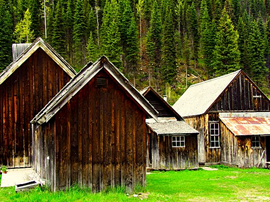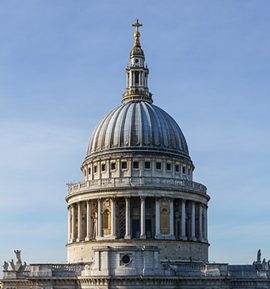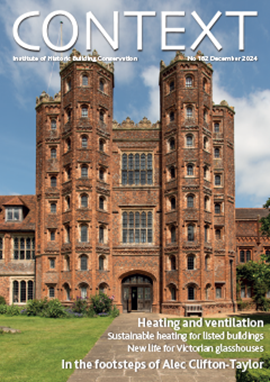Crown glass
Historic England 2020 Stained Glass Windows: Managing Environmental Deterioration, Swindon, published by Historic England in 2020 defines crown glass, or spun glass as a: “Method of producing sheet glass by hand. A bubble of molten glass is transferred onto a solid metal ‘punty rod’, or ‘pontil rod’, which can be spun between the hands of the glass blower. The blowing pipe is then cut away, and the molten glass spun using the punty rod until it suddenly opens out into a disc, or ‘table’. The earliest known crown glass in England dates from the 1440s; it was widely used for windows until the mid-19th century, when taxation by weight ceased and cylinder glass became cheaper.”
Maintaining traditional plain glass and glazing, published on 1 November 2007 by Historic Scotland, states: ‘Crown glass was made by blowing and then spinning molten glass into a large thin disc known as a ‘table’ which was then cut into smaller panes. The glass is slightly curved and distinctive semi-circular lines called the ‘ream’ can often be seen in the glass. Crown glass is thinner than cylinder glass, but is also brighter and shinier as it never came in contact with a hard surface while molten. The seed lies in concentric circles, and panes often have a ‘bellied’ appearance when used in windows. Crown glass became increasingly popular from the middle of the 18th Century.’
NB Archaeological Evidence for Glassworking, Guidelines for Recovering, Analysing and Interpreting Evidence, published by Historic England in 2018, defines a pontil scar as: 'The circular protrusion of glass left on a glass object after removal of the pontil iron, although it was ground away on finer vessels.'
[edit] Related articles on Designing Buildings
IHBC NewsBlog
SAVE celebrates 50 years of campaigning 1975-2025
SAVE Britain’s Heritage has announced events across the country to celebrate bringing new life to remarkable buildings.
IHBC Annual School 2025 - Shrewsbury 12-14 June
Themed Heritage in Context – Value: Plan: Change, join in-person or online.
200th Anniversary Celebration of the Modern Railway Planned
The Stockton & Darlington Railway opened on September 27, 1825.
Competence Framework Launched for Sustainability in the Built Environment
The Construction Industry Council (CIC) and the Edge have jointly published the framework.
Historic England Launches Wellbeing Strategy for Heritage
Whether through visiting, volunteering, learning or creative practice, engaging with heritage can strengthen confidence, resilience, hope and social connections.
National Trust for Canada’s Review of 2024
Great Saves & Worst Losses Highlighted
IHBC's SelfStarter Website Undergoes Refresh
New updates and resources for emerging conservation professionals.
‘Behind the Scenes’ podcast on St. Pauls Cathedral Published
Experience the inside track on one of the world’s best known places of worship and visitor attractions.
National Audit Office (NAO) says Government building maintenance backlog is at least £49 billion
The public spending watchdog will need to consider the best way to manage its assets to bring property condition to a satisfactory level.
IHBC Publishes C182 focused on Heating and Ventilation
The latest issue of Context explores sustainable heating for listed buildings and more.















